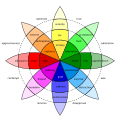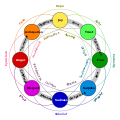Emotion recognition in conversation
Emotion recognition in conversation (ERC) is a sub-field of emotion recognition, that focuses on mining human emotions from conversations or dialogues having two or more interlocutors.[1] The datasets in this field are usually derived from social platforms that allow free and plenty of samples, often containing multimodal data (i.e., some combination of textual, visual, and acoustic data).[2] Self- and inter-personal influences play critical role[3] in identifying some basic emotions, such as, fear, anger, joy, surprise, etc. The more fine grained the emotion labels are the harder it is to detect the correct emotion. ERC poses a number of challenges,[1] such as, conversational-context modeling, speaker-state modeling, presence of sarcasm in conversation, emotion shift across consecutive utterances of the same interlocutor.
The task
The task of ERC deals with detecting emotions expressed by the speakers in each utterance of the conversation. ERC depends on three primary factors – the conversational context, interlocutors' mental state, and intent.[1]
Datasets
IEMOCAP,[4] SEMAINE,[5] DailyDialogue,[6] and MELD[7] are the four widely used datasets in ERC. Among these four datasets, MELD contains multiparty dialogues.
Methods
Approaches to ERC consist of unsupervised, semi-unsupervised, and supervised[8] methods. Popular supervised methods include using or combining pre-defined features, recurrent neural networks [9] (DialogueRNN[10]), graph convolutional networks [11] (DialogueGCN [12]), and attention gated hierarchical memory network.[13] Most of the contemporary methods for ERC are deep learning based and rely on the idea of latent speaker-state modeling.
Emotion Cause Recognition in Conversation
Recently a new subtask of ERC has emerged that focuses on recognising emotion cause in conversation.[14] Methods to solve this task rely on language models-based question answering mechanism. RECCON[14] is one of the key datasets for this task.
See also
References
- ^ S2CID 147703962.
- S2CID 12710581.
- arXiv:1910.04980 [cs.CL].
- S2CID 11820063.
- S2CID 2995377.
- ^ Li, Yanran, Hui Su, Xiaoyu Shen, Wenjie Li, Ziqiang Cao, and Shuzi Niu. "DailyDialog: A Manually Labelled Multi-turn Dialogue Dataset." In Proceedings of the Eighth International Joint Conference on Natural Language Processing (Volume 1: Long Papers), pp. 986-995. 2017.
- S2CID 52932143.
- )
- arXiv:1701.08071 [cs.CL].
- ISSN 2374-3468.
- ^ "Graph Convolutional Networks are Bringing Emotion Recognition Closer to Machines. Here's how". Tech Times. 2019-11-26. Retrieved February 25, 2020.
- ^ Ghosal, Deepanway; Majumder, Navonil; Soujanya, Poria (Aug 2019). DialogueGCN: A Graph Convolutional Neural Network for Emotion Recognition in Conversation. Conference on Empirical Methods in Natural Language Processing (EMNLP).
- arXiv:1911.09075 [cs.CL].
- ^ S2CID 229349214.


